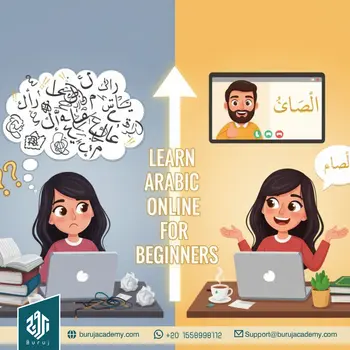From ‘Alif’ to ‘Yaa’: A Beginner’s Journey to learn Arabic online
Layla had always felt a pull toward the language. It was the rhythm of her grandmother’s prayers, the melodic flow of recitations during Ramadan, and the linguistic key to a history that felt both personal and vast. She was determined to learn Arabic online for beginners, yet every time she started, she was met with a wall of confusion. The internet, a resource of infinite knowledge, ironically became the biggest obstacle.
Her desire was clear IS to move from total novice to being able to read and understand basic texts. Specifically a short Surah from the Quran, connecting her spiritual and cultural self. But the path to this goal was anything but clear.
The Search: Looking for a Specific, Accessible Starting Point to learn Arabic online for beginners
The initial phase of Layla’s pursuit was marked by deep frustration. She downloaded several language apps, each promising fluency in minutes, but quickly found they were designed for rote memorization of tourist phrases, not true linguistic mastery. She needed more than just how to ask, “Where is the bathroom?” She needed grammar, structure, and pronunciation guidance from someone who truly understood the nuances of the language. Layla wish to learn Arabic online for beginners.
Free Trial Session Contact Us
Her attempts at self-study were similarly fragmented. One week, she was watching a random YouTube video about verb conjugations; the next, she was trying to decipher an ancient-looking textbook on Modern Standard Arabic (MSA). The material was either too light and conversational or too heavy and academic. There was no scaffolding, no clear progression from ‘Level 1’ to ‘Level 2.’
The core problem, as Layla realized, was the lack of a specific, accessible starting point. She wasn’t looking for scattered pieces of a puzzle; she was looking for the entire, clearly labelled box. She felt isolated, trying to piece together a complex linguistic system from unrelated, often contradictory, sources. If she was truly going to succeed, she needed to learn Arabic online for beginners through a cohesive, curated system.
The sheer variety was overwhelming. Should she study Gulf dialect, Egyptian dialect, or focus solely on Quranic Arabic? Which curriculum was the most reliable? Without a guide, she was spending more time searching for the right way to learn than actually learning. This paralysis of choice was a common pitfall for every aspiring student.
The Discovery: Structure and Support to learn Arabic for beginners
One evening, after closing yet another browser tab filled with half-read articles on Arabic roots, Layla decided to refine her search. She typed: “best structured program to learn Arabic online for beginners with native tutors.”
The results led her to an online institute that specialized in beginner immersion. Their key selling point was their modular, step-by-step curriculum, which was clearly laid out from Day 1. It wasn’t just about apps or flashcards; it was a full learning environment complete with video lectures, interactive quizzes, and, most importantly, scheduled one-on-one sessions with certified, native-speaking teachers.
Check out Buruj Academy’s Arabic courses today!
to learn Arabic online for beginners.
What immediately stood out was the clarity. The first module, appropriately named ‘Foundations,’ focused exclusively on the Arabic alphabet (Alif to Yaa), letter shapes in context, and correct articulation—the very things she had struggled to master from generic videos. This was the specific, accessible starting point she had been looking for.
Layla signed up. Learn more about our Pricings
Chapter 1: Mastering ‘Alif’ and the Art of Articulation
The first few weeks were intense, yet deeply rewarding. Her teacher, Ustadh Omar, was based in Cairo and brought a calming patience to their virtual classroom. He didn’t just tell her how to pronounce the letters; he used visual aids and repetition to show her the correct mouth and throat positions for the guttural sounds that had previously eluded her.
Layla learned the three primary forms of each letter—initial, medial, and final—not as confusing exceptions, but as a logical flow within the script. The platform provided interactive practice tools that allowed her to trace the letters on her screen, correcting her strokes instantly.
The lesson on Tajweed, the rules of recitation, was introduced early but simply, focusing first on the correct elongation of vowels. This initial grounding gave her a profound sense of confidence. She was no longer guessing. She was building a solid base. Every lesson reinforced the idea that if you are serious about this goal, you must learn Arabic online for beginners with a program that prioritizes fundamental accuracy over quick, superficial gains.
Check out Buruj Academy’s Arabic courses today!
Chapter 2: Building Blocks of Meaning
With the alphabet mastered, Layla moved into the second module: Introduction to Nominal Sentences and High-Frequency Vocabulary. This section seamlessly blended MSA grammar—the foundation for both contemporary communication and formal Islamic texts—with practical, high-utility vocabulary.
She learned how Arabic roots function—that three-letter sequence that dictates a word’s core meaning. Understanding the root k.t.b (to write) immediately unlocked words like kitab (book), maktab (office/desk), and katib (writer). This structural approach made the daunting task of vocabulary acquisition feel logical and manageable.
The online environment proved ideal for this stage. She could rewatch the grammar videos whenever she encountered confusion, practice sentence construction in forums with other students. And use her weekly one-on-one sessions with Ustadh Omar to drill pronunciation and discuss the exceptions to the rules. The flexibility of the learn Arabic online for beginners format allowed her to balance her full-time job with her studies, reviewing flashcards on her commute and dedicating her evenings to video lessons. The structure prevented the old problem of jumping ahead or missing crucial foundational knowledge.
Chapter 3: The Connection Solidifies
As Layla progressed, the true goal of her journey came into sharper focus. She had always wanted to connect with the divine text, and now the curriculum offered a dedicated path into Quranic Reading.
The platform introduced short verses, focusing on the common sight words and simple grammatical patterns found frequently in the Quran. The sound files provided crystal-clear recitation, allowing Layla to imitate the rhythm and flow precisely. This practice wasn’t just about reading; it was about internalizing the melody, connecting the visual script to the auditory beauty she remembered from her childhood.
There was a moment when Layla recognized the word al-hamdu (the praise) from her studies in the first few words of a verse she had heard thousands of times. It wasn’t just a sound anymore; it was a recognized structure, a grammatical entity she understood. That small flicker of intellectual understanding coupled with the spiritual resonance was a powerful motivator. The accessibility of the online course had finally bridged the gap between passive listening and active comprehension.
Climax: The First Full Surah
It was a quiet Tuesday evening, two months after Layla had started her structured course. She had finished the beginner modules and was reviewing her work before starting the intermediate level. Then decided to test herself.
After that opened the page for Surah Al-Ikhlas (Chapter 112). And had recited this Surah countless times from memory, but she had never truly read it, connecting each letter, each word, to her own knowledge.
began, carefully, deliberately:
- قُلْ هُوَ اللَّهُ أَحَدٌ
- Qul (Say) – I know that’s an imperative verb!
- Huwa (He is) – A pronoun.
- Allahu Ahad (God is One) – A clear, simple nominal sentence structure.
Then proceeded through the four short verses. And paused for the correct elongation, articulated the deep Ha and the sharp Qaf, and felt the simple, majestic power of the words she was forming.
When she finished, a warmth spread through her. She hadn’t just spoken the words; she had read them. The journey from the first isolated letter Alif to this complete, meaningful text, Yaa, had culminated in this small, sacred moment of genuine connection.
This transformation was proof that the initial problem—the lack of a specific, accessible starting point—had been utterly resolved by a dedicated, structured approach.
A Clear Path Forward
Layla’s journey demonstrated a crucial lesson for anyone looking to learn Arabic online for beginners: the key to success is not in the quantity of resources. But in the quality and structure of one specific resource. By choosing a system designed for genuine mastery, complete with clear modules, native guidance, and a focus on both MSA and the foundations of Quranic reading. she moved past the initial paralysis and into true learning.
If you are currently overwhelmed, trying to piece together a coherent learning plan from fragmented YouTube clips and random apps, take Layla’s experience to heart. The most effective way to begin is by finding a reputable, structured course specifically tailored to your beginner needs. This is the only way to ensure you build the solid foundational knowledge required for both fluency and deep comprehension. Transforming the intimidating world of Arabic into a clear, accessible path.
Now, Layla is studying the complexities of verb conjugations, eagerly anticipating the day she can read longer Surahs.
Connect with Our Community
High-value education extends beyond the classroom. We provide free resources and a supportive community to help you on your journey. For free tips, student stories follow us on Facebook, watch our educational lessons on YouTube, and join the conversation on Instagram.





